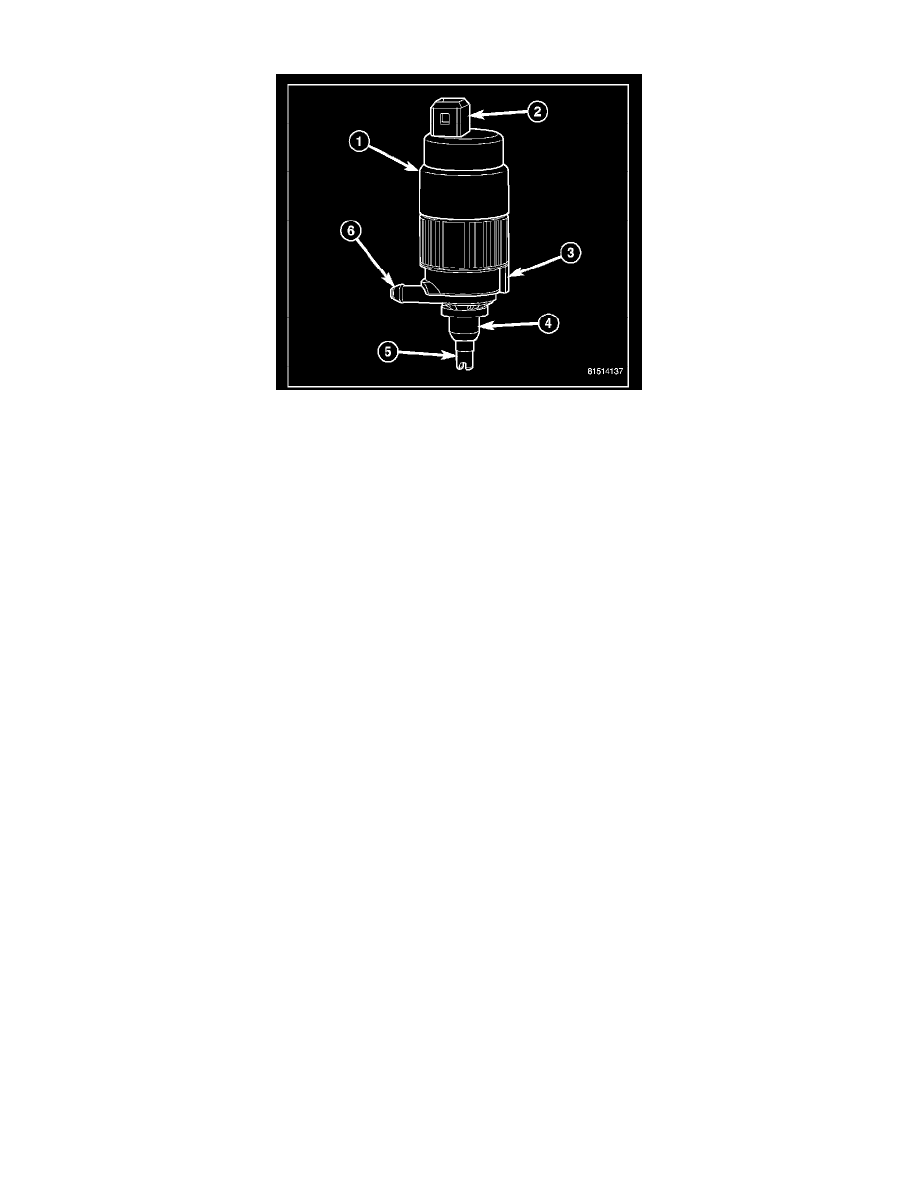Dakota 2WD V8-4.7L VIN J (2005)

Windshield Washer Pump: Description and Operation
The washer pump/motor unit (1) is located on the top of a sump area on the outward facing side of the combination washer reservoir/ coolant reserve
bottle, ahead of the right front fender wheel house splash shield. A small permanently lubricated and sealed reversible electric motor is coupled to the
rotor-type washer pump (3).
An inlet nipple (5) on the bottom of the pump housing passes through a rubber grommet seal (4) installed in a dedicated mounting hole of the washer
reservoir. When the pump is installed in the reservoir the barbed outlet nipple (6) on the pump valve body housing points rearward and connects the unit
to the reservoir washer hose, which is engaged in an integral trough molded into the reservoir/bottle unit.
The washer pump/motor unit is retained on the reservoir by the interference fit between the pump inlet nipple and the grommet seal, which is a light
press fit. The top of the washer pump is also secured to the washer reservoir by the use of a snap fit into a receptacle molded into the reservoir that
allows for mounting of the washer pump without the use of fasteners. An integral connector receptacle (2) on the top of the motor housing connects the
unit to the vehicle electrical system through a dedicated take out and connector of the headlamp and dash wire harness.
The washer pump/motor unit cannot be repaired. If faulty or damaged, the entire washer pump/motor unit must be replaced.
The washer pump/motor unit features a small Direct Current (DC) electric motor. The motor is connected to the vehicle electrical system through a
single take out and two-cavity connector of the headlamp and dash wire harness. The motor is grounded at all times through another take out of the
headlamp and dash wire harness with a single eyelet terminal connector that is secured by a nut to a ground stud located on the right front fender inner
shield in the engine compartment.
The motor receives battery current on a washer pump/motor control circuit. The washer pump/motor control circuit is energized through a high side
driver within the Front Control Module (FCM) whenever the FCM receives an electronic message requesting washer system operation from the
ElectroMechanical Instrument Cluster (EMIC) over the Controller Area Network (CAN) data bus. The EMIC monitors a resistor multiplexed hard wired
input from the momentary washer switch contacts within the multi-function switch on the steering column to determine when it should issue the
electronic message requesting washer system operation.
Washer fluid is gravity-fed from the washer reservoir to the inlet side of the washer pump. When the pump motor is energized, the motor spins the rotor
within the washer pump. The spinning pump rotor pressurizes the washer fluid and forces it through the pump outlet nipple, the washer plumbing, and
the washer nozzles onto the windshield glass.
The washer pump/motor unit and the hard wired motor control circuit from the FCM may be diagnosed and tested using conventional diagnostic tools
and procedures. However, conventional diagnostic methods may not prove conclusive in the diagnosis of the FCM, the EMIC, the CAN data bus, or the
electronic messages used to provide washer pump/motor unit control. The most reliable, efficient, and accurate means to diagnose the FCM, the EMIC,
the CAN data bus, and the electronic messages for the washer pump/motor unit control requires the use of a diagnostic scan tool.
